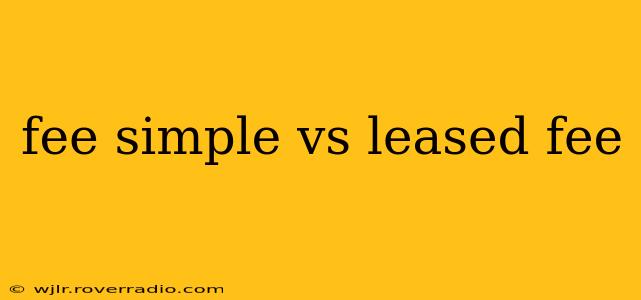Understanding the nuances of real estate ownership is crucial for investors, landlords, and tenants alike. Two fundamental concepts often cause confusion: fee simple and leased fee. This comprehensive guide will clarify the differences between these two ownership interests, highlighting their implications for investment strategies and property management.
What is Fee Simple Ownership?
Fee simple, often referred to as fee simple absolute, represents the highest form of ownership in real estate. It grants the owner complete control and rights to the property, including the right to possess, use, enjoy, and dispose of the land as they see fit, subject only to limitations imposed by government regulations (like zoning laws) or existing easements (rights of way granted to others). Essentially, the owner has virtually unlimited rights to the property, lasting potentially forever. This is often thought of as outright ownership.
Key Characteristics of Fee Simple:
- Complete Ownership: The owner has absolute control and rights to the property.
- Inheritance: The ownership is inheritable; it can be passed down to heirs.
- Indefinite Duration: The ownership lasts indefinitely, unless the owner chooses to sell, gift, or otherwise transfer it.
- Transferable: The ownership can be freely transferred through sale, gift, or will.
What is Leased Fee Ownership?
Leased fee ownership refers to the ownership interest retained by the landlord after granting a lease to a tenant. The landlord owns the underlying land and building, but the tenant has the right to use and occupy the property for a specified period. The landlord's ownership is subject to the lease agreement's terms and conditions. The landlord receives rent in exchange for granting the tenant the right to use the property.
Key Characteristics of Leased Fee:
- Partial Ownership: The landlord's ownership is limited by the lease agreement.
- Right to Receive Rent: The landlord receives rent payments from the tenant.
- Limited Control: The landlord's control over the property is restricted by the lease agreement's terms.
- Reversionary Interest: Once the lease expires, the landlord regains full control and possession of the property.
Fee Simple vs. Leased Fee: A Comparison Table
| Feature | Fee Simple | Leased Fee |
|---|---|---|
| Ownership | Complete and unrestricted | Partial, subject to lease terms |
| Control | Full control | Limited control during the lease term |
| Duration | Indefinite | Limited to the lease term |
| Income | Potential rental income (if rented out) | Guaranteed rental income (during lease term) |
| Transferability | Freely transferable | Transferability is affected by lease terms |
| Risk | Higher risk (responsible for all costs) | Lower risk (tenant responsible for some costs) |
| Return | Potential for higher appreciation | Stable income stream, lower appreciation potential |
What are the potential benefits and drawbacks of each?
Fee Simple Benefits:
- Potential for appreciation: Property values can increase significantly over time.
- Full control: You make all decisions regarding the property.
- Long-term investment: Can be a valuable asset for generations.
Fee Simple Drawbacks:
- Higher initial investment: Requires a larger upfront investment.
- Responsibility for all costs: You are responsible for all maintenance, taxes, and insurance.
- Vacancy risk: If you rent it out, you risk periods of vacancy.
Leased Fee Benefits:
- Stable income stream: Guaranteed rental income during the lease term.
- Lower initial investment: Requires a smaller upfront investment than fee simple.
- Lower risk: Tenants are responsible for some maintenance and repairs.
Leased Fee Drawbacks:
- Limited appreciation: The value appreciation is limited during the lease term.
- Limited control: Your ability to make changes to the property is restricted by the lease.
- Tenant issues: Potential for dealing with problematic tenants.
How are these different types of ownership used in investment strategies?
Investors often utilize both fee simple and leased fee ownership in different strategies. Fee simple is ideal for long-term appreciation and capital growth, while leased fee provides a stable income stream with less risk. Some investors might use a combination of both to diversify their portfolio and balance risk and return.
What are the tax implications of each type of ownership?
Tax implications for both fee simple and leased fee ownership can be complex and vary depending on jurisdiction and individual circumstances. Consult with a tax professional for specific advice related to your situation.
This information is for general knowledge and understanding only, and does not constitute financial or legal advice. Always consult with qualified professionals before making any real estate investment decisions.
